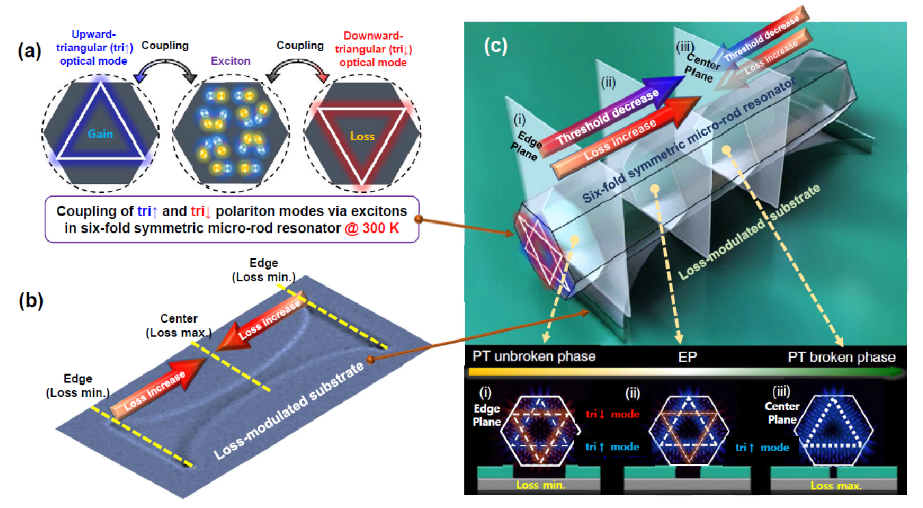When there is a loss in a laser system requiring a gain, the minimum energy required for operation (i.e., the threshold energy) increases by the same amount. Accordingly, this, type of loss should be reduced as much as possible. However, when the concept of PT symmetry and breaking as existing in quantum mechanics is applied to an optical system with a mathematical analogy, a unique optical system that can use losses in a beneficial manner is created. Essentially, because light particles do not interact with each other, in order to implement a photonic system with PT symmetry using light, two or more spatially separated photonic components must be produced identically without errors. It is also necessary to use photonic components under sophisticated conditions in which the loss and gain can be individually controlled.
Professor Yong-Hoon Cho’s research team devised an intriguing method that can directly control the interaction between different modes within a single hexagonal microcavity using polaritons, which are highly interactive with each other, unlike light. If light is present for a long time and strongly interacts with excitons (i.e., a bound state of an electron and a hole by electrostatic Coulomb interaction) inside a semiconductor, it is possible to create quasiparticles called polaritons, which have both exciton and light characteristics. In a single resonator with hexagonal symmetry, two optical modes with identical energy levels and paths in the form of upward and downward triangles exist without interaction with light. The research team focused on the possibility that direct interaction would be possible if using polaritons.
Of the different modes, only the downward triangular mode was combined with a loss-modulated substrate so that the amount of loss could be continuously adjusted. Through this, it was observed at room temperature that the threshold energy decreases as the loss increases. This is a result contrary to the general intuition that the energy required for operation increases as the loss becomes greater. It overcomes the complexity of the existing photonic PT symmetry system and uses only a single semiconductor micro-resonator to develop a PT symmetric system for the first time.
A system to which such PT symmetry is applied is an important platform that allows the loss, which had to be eliminated or overcome, to be used as consequently a gain. This platform can be used to reduce the laser threshold energy, can be applied not only to classical optical devices such as nonlinear optical devices and sensitive optical sensors, but also to irreversible devices that can control the direction of light, as well as superfluid-based quantum optical devices.
This work was supported by the Samsung Science and Technology Foundation and the National Research Foundation of the Korea government. It was published online on the 10th of June in Nature Photonics.

Dr. Hyun Gyu Song and Prof. Yong-Hoon Cho Department of Physics and KI for the NanoCentury, KAIST
Homepage: http://qnp.kaist.ac.kr
E-mail: yhc@kaist.ac.kr






